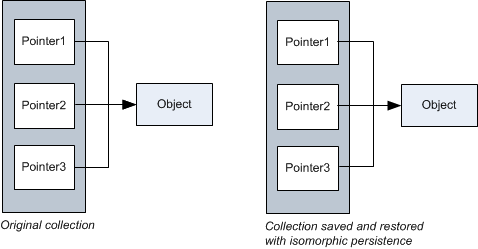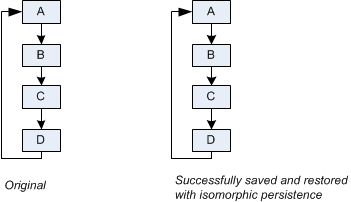Isomorphic versus Simple Persistence
Here are two illustrations that show the difference between isomorphic and simple persistence. In Figure 2, a collection of multiple pointers to the same object is saved to and restored from a stream, using simple persistence. Notice that when the collection is stored and restored in Figure 2, each pointer points to a distinct object. Contrast this with the isomorphic persistence of the same collection, shown in Figure 3, in which all of the restored pointers point to the same object, just as they did in the original collection.
Figure 2 – Saving and restoring with simple persistence. 

Figure 3 – Saving and restoring a Collection with isomorphic persistence 

In Figure 4, we attempt to save and restore a circularly-linked list, using simple persistence. As shown in the figure, any attempt to use simple persistence to save a circularly-linked list results in an infinite loop.
The simple persistence mechanism creates a copy of each object that is pointed to and saves that object to a stream. But the simple persistence mechanism doesn't remember which objects it has already saved. When the simple persistence mechanism encounters a pointer, it has no way of knowing whether it has already saved that pointer's object. So in a circularly-linked list, the simple persistence mechanism saves the same objects over and over and over as the mechanism cycles through the list forever.
On the other hand, as shown in Figure 5, isomorphic persistence allows us to save the circularly-linked list. The isomorphic persistence mechanism uses a table to keep track of pointers it has saved. When the isomorphic persistence mechanism encounters a pointer to an unsaved object, it copies the object data, saves that object data—not the pointer—to the stream, then keeps track of the pointer in the save table. If the isomorphic persistence mechanism later encounters a pointer to the same object, instead of copying and saving the object data, the mechanism saves the save table's reference to the pointer.
When the isomorphic persistence mechanism restores pointers to objects from the stream, the mechanism uses a restore table to reverse the process. When the isomorphic persistence mechanism encounters a pointer to an unrestored object, it recreates the object with data from the stream, then changes the restored pointer to point to the recreated object. The mechanism keeps track of the pointer in the restore table. If the isomorphic persistence mechanism later encounters a reference to an already-restored pointer, then the mechanism looks up the reference in the restore table, and updates the restored pointer to point to the object referred to in the table.
Figure 4 – Attempt to save and restore a circularly-linked list with simple persistence 

Figure 5 – Saving and restoring a circularly-linked list with isomorphic persistence 






